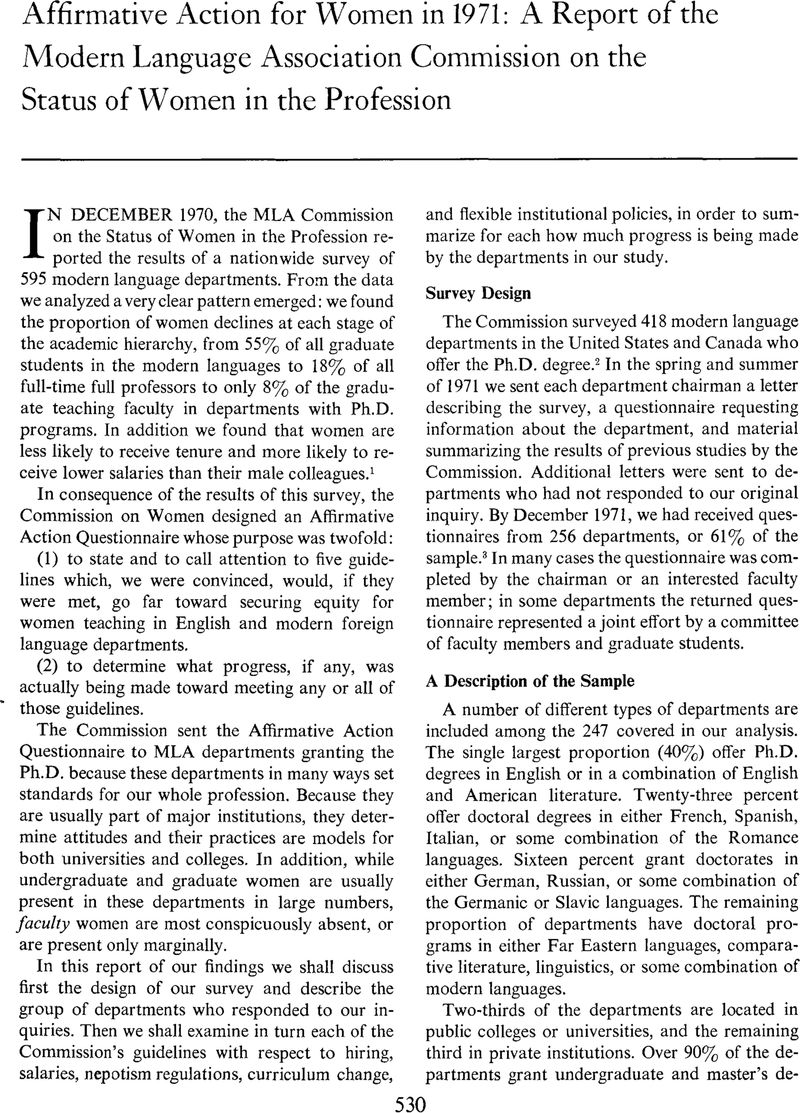No CrossRef data available.
Article contents
Affirmative Action for Women in 1971: A Report of the Modern Language Association Commission on the Status of Women in the Profession
Published online by Cambridge University Press: 01 December 2020
Abstract

- Type
- Other
- Information
- Copyright
- Copyright © Modern Language Association of America, 1972
References
1 See Florence Howe, Laura Morlock, and Richard Berk, “The Status of Women in Modern Language Departments : A Report of the Modern Language Association Commission on the Status of Women in the Profession,” PMLA, 86 (1971), 459–68.
2 We tried to include in the survey all departments in the United States and Canada with a doctoral program in modern languages. In order to compile such a list we used the most complete guide to doctoral programs currently available: Robert Quick, A Guide to Graduate Study: Programs Leading to the Ph.D. Degree (Washington, D. C: American Council of Education, 1969). With this source it is sometimes difficult to distinguish whether degrees are granted by a department or an interdepartmental or extra-departmental program. In addition, some of the departments included in this source have recently dissolved or merged with other programs. For these reasons, we realize that our list of departments included in the appendix which did not return questionnaires may contain inaccuracies.
3 Nine questionnaires arrived too late to be included in the analysis. Therefore, the results included in this report are based on the responses of 247 departments.
4 There are striking differences between departments in public and private institutions in the percentage of women among doctoral degrees recently awarded : women represent 36% of new Ph.D.'s in private settings and only 27% in departments within public colleges and universities.
5 At least one study on the status of women has been completed in each of the following: American studies, anthropology, history, immunology, legal education, library science, medical education, microbiology, political science, psychology, sociology. There are also several general stud ies comparing the status of women across disciplines. Surveys are now in progress in philosophy and physics, and are being planned in art education as well as in other areas. For lists of references see the articles included in Alice Rossi, Academic Women on the Move (Russell Sage, forthcoming).
6 This discrepancy was discovered in a comparative study of the salaries of men and women faculty members at the Univ. of Wisconsin. However, such large discrepancies in salaries are certainly not unique to that institution.
7 For a discussion on the effect of antinepotism policies on the employment of women see Carol Ohmann, “Anti-Nepotism Rules and Practices,” a report prepared for the Modern Language Association Commission on the Status of Women in the Profession, 1970; and the AAUP policy statement, “Faculty Appointment and Family Relationship,” AAUP Bulletin, 57 (Summer 1971), 221.
8 See Florence Howe and Carol Ahlum, eds., Female Studies III (Pittsburgh: KNOW, Inc., 1971).
9 It is interesting to note that these departments are not, as a group, the most prestigious in the sample, nor do they seem to differ in any other systematic way from departments which do admit part-time students.
10 For a list of these institutions, as well as a summary of these study results, see Lora Robinson, “The Institutional Status of Faculty Women,” in Rossi, Academic Women on the Move.
11 These formal charges of sex discrimination are filed with the Secretary of the Department of Health, Education and Welfare under Executive Order 11246 as amended, which forbids all federal contractors from discriminating on the basis of race, color, religion, national origin, and sex.


